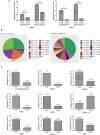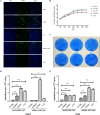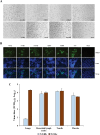Contribution of critical amino acid residues in the RNA-dependent RNA polymerase to the replication fidelity and viral ribavirin sensitivity of porcine reproductive and respiratory syndrome virus
- PMID: 40253380
- PMCID: PMC12008895
- DOI: 10.1186/s13567-025-01517-9
Contribution of critical amino acid residues in the RNA-dependent RNA polymerase to the replication fidelity and viral ribavirin sensitivity of porcine reproductive and respiratory syndrome virus
Abstract
The porcine reproductive and respiratory syndrome virus (PRRSV) has the highest mutation rate of any known RNA virus. The replication fidelity of RNA viruses can be modulated by subtle amino acid changes in the viral RNA-dependent RNA polymerase (RdRp). In our study, two novel amino acid substitutions (V218I and P386S) in the RdRp of PRRSV were identified under the ribavirin selection. A series of mutant viruses with single or double amino acid replacements were generated from high-fidelity PRRSV NJ-Rb and wild-type NJ-a P80 infectious cDNA clones. Subsequently, we evaluated the genetic stability, ribavirin sensitivity, and biological characteristics of the recombinant viruses. Our findings indicated that the mutation frequencies of the recombinant mutants (vI218V, vS386P, and vVP) based on NJ-Rb were significantly increased and that these recombinant viruses exhibited a loss of ribavirin resistance. The high-fidelity virus NJ-Rb was undetectable using a virus titration assay in porcine alveolar macrophages (PAMs). Our in vivo experiments demonstrated that NJ-Rb was nearly incapable of establishing infection and replicating in the lungs. The recombinant mutants vV218I, vP386S, and vIS, based on NJ-a P80, significantly increased replication fidelity and ribavirin resistance. These results indicated that PRRSV RdRp (NSP9) contained fidelity checkpoints. Furthermore, Val218 and Pro386 were identified as critical sites that determined PRRSV's genetic stability and ribavirin resistance. These findings contribute to understanding how RdRp affects PRRSV's genetic stability and ribavirin sensitivity and provide a theoretical basis for designing a genetically stable high-fidelity PRRSV vaccine.
Keywords: PRRSV; RdRp; replication fidelity; ribavirin sensitivity.
© 2025. The Author(s).
Conflict of interest statement
Declarations. Ethics approval and consent to participate: The Animal Care and Ethics Committee of Yichun University (Permit No. JXSTUDKY2024006) approved the animal study. All animal experiments were conducted per the local legislation and institutional requirements. Written informed consent was obtained from the owners for the participation of their animals in this study. Competing interests: The authors declare that they have no competing interests.
Figures








Similar articles
-
Amino acid residues Ala283 and His421 in the RNA-dependent RNA polymerase of porcine reproductive and respiratory syndrome virus play important roles in viral ribavirin sensitivity and quasispecies diversity.J Gen Virol. 2016 Jan;97(1):53-59. doi: 10.1099/jgv.0.000316. Epub 2015 Oct 19. J Gen Virol. 2016. PMID: 26487085
-
The Attenuation Phenotype of a Ribavirin-Resistant Porcine Reproductive and Respiratory Syndrome Virus Is Maintained during Sequential Passages in Pigs.J Virol. 2016 Apr 14;90(9):4454-4468. doi: 10.1128/JVI.02836-15. Print 2016 May. J Virol. 2016. PMID: 26889041 Free PMC article.
-
Two Residues in NSP9 Contribute to the Enhanced Replication and Pathogenicity of Highly Pathogenic Porcine Reproductive and Respiratory Syndrome Virus.J Virol. 2018 Mar 14;92(7):e02209-17. doi: 10.1128/JVI.02209-17. Print 2018 Apr 1. J Virol. 2018. PMID: 29321316 Free PMC article.
-
Overview: Replication of porcine reproductive and respiratory syndrome virus.J Microbiol. 2013 Dec;51(6):711-23. doi: 10.1007/s12275-013-3431-z. Epub 2013 Dec 19. J Microbiol. 2013. PMID: 24385346 Free PMC article. Review.
-
Incorporation fidelity of the viral RNA-dependent RNA polymerase: a kinetic, thermodynamic and structural perspective.Virus Res. 2005 Feb;107(2):141-9. doi: 10.1016/j.virusres.2004.11.004. Virus Res. 2005. PMID: 15649560 Free PMC article. Review.
References
-
- Bloemraad M, de Kluijver EP, Petersen A, Burkhardt GE, Wensvoort G (1994) Porcine reproductive and respiratory syndrome: temperature and pH stability of Lelystad virus and its survival in tissue specimens from viraemic pigs. Vet Microbiol 42:361–371 - PubMed
-
- Holtkamp DJ, Kliebenstein JB, Neumann EJ, Zimmerman JJ, Rotto HF, Yoder TK, Wang C, Yeske PE, Mowrer CL, Haley CA (2013) Assessment of the economic impact of porcine reproductive and respiratory syndrome virus on United States pork producers. J Swine Health Prod 21:72–84
-
- Xing J, Zheng Z, Cao X, Wang Z, Xu Z, Gao H, Liu J, Xu S, Lin J, Chen S, Wang H, Zhang G, Sun Y (2022) Whole genome sequencing of clinical specimens reveals the genomic diversity of porcine reproductive and respiratory syndrome viruses emerging in China. Transbound Emerg Dis 69:e2530–e2540 - PubMed
MeSH terms
Substances
Grants and funding
LinkOut - more resources
Full Text Sources
Research Materials

